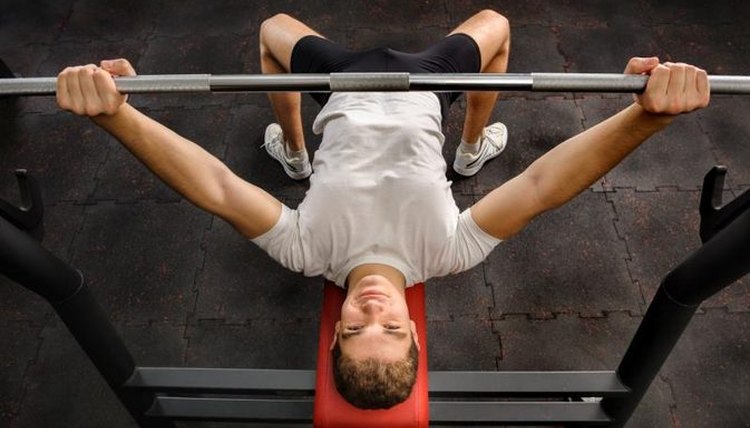How to Build Stabilizer Muscles for Bench Presses

The bench press is often labeled the “king of upper-body exercises.” While opinions vary, there's no arguing that the bench press requires an appreciable amount of strength, and more importantly, stabilizer strength to perform optimally and safely.
Stabilizing muscles are muscles or muscle groups that help maintain the optimal position of a joint by contributing to joint stiffness. The stabilizers work to help mitigate the influence of the larger muscles in order to maintain an optimal and efficient alignment of the joints.
When the stabilizers for the bench press are strong and efficient, they allow the prime movers such as the chest, shoulders and triceps to exert the most force possible.
If the stabilizers are not strong and able to perform at a high degree, the prime movers do not have a solid base to work from and therefore can not apply as much force to move the weight. Worse, when the stabilizing muscles are not doing their job, you are at a greater risk for injury.
Stabilizing Muscles for the Bench Press
The joints that are involved directly in the bench press include the shoulder, shoulder girdle, elbow and the often-forgotten, but just as important series of joints, the spine.
The muscles that help stabilize, or keep these joints in a neutral position, include the rotator cuff for the shoulder, the scapular (shoulder blade) stabilizers for the shoulder girdle, the forearm muscles for the elbow and the core muscles for the spine.
In order to strengthen these muscle groups, focus on a few key exercises utilizing a method that helps develop them simultaneously.
Bottoms-Up Kettlebell Presses
When you challenge your grip strength to a greater degree, as you do using kettle bells because of the unbalanced load, your rotator cuff activates as a result.
This is known as the phenomenon of irradiation, which encourages the activation of muscles through the contraction of other muscles.
Taking that a step further, placing a kettlebell in the bottoms up position where the belly of the kettlebell is upside down relative to gravity, creates an even greater grip demand and therefore greater stability demand .
Not only will the rotator cuff be activated to a greater degree, but the musculature of the forearm as well as the shoulder girdle and core are forced to work to stabilize the joints surrounding the shoulder in order to efficiently transfer energy throughout the entire system.
By enhancing your ability to stabilize the bottoms up kettlebell position with various pressing exercises such as those that follow, you are increasing the strength and capacity of the stabilizing muscles that are required for the bench press.
Exercises such as bottoms up kettlebell press variations from different positions are a great option. The pressing exercises are pattern specific with regards to the bench press, and therefore will have the greatest benefit for the bench press.
1. Bottoms Up Kettlebell Bench Press
With regards to the bench press, the most specific exercise you can perform with the bottoms up kettlebell position.
With this exercise you are in the exact position that you will be in when performing the bench press, but with the kettlebell the stability demand and strengthening of the forearms, rotator cuff, shoulder girdle muscles and core will be to a much greater extent.
HOW TO DO IT: Lie on your back on a bench. Using a kettlebell in the bottoms up position, keep the abs engaged to keep your low back pressed to the bench. Press the kettlebell toward the ceiling, using a very tight grip as if you were trying to crush the handle of the kettle bell.
Lower the kettlebell under control focusing on pulling your shoulder blade underneath your upper back as you descend the the weight. Do not allow the elbow to pass too far behind the body or the shoulder blade to tip forward.
2. Half Kneeling BU Press
A vertical press also targets the large muscles, as well as the stabilizing muscles that are used in the bench press.
Working from the half kneeling position forces you to utilize your core to keep the position solid as you press the kettlebell overhead. Once again, the bottoms up position of the kettlebell demands more stability from the muscles of the forearm, shoulder, shoulder girdle and core.
HOW TO DO IT: Start in a half kneeling position with one knee on the ground and the other foot flat on the floor in front of you both knees are bent at 90 degrees. With the arm on the side of the down knee, grasp a kettlebell in the bottoms up position, holding it so your fist is in line with your shoulder.
Keep the abs engaged to prevent the low back from arching as you press the kettlebell straight overhead. Make sure to allow the shoulder blade to come up and around the rib cage to maximize the stabilizing muscles of the shoulder girdle. Lower the weight slowly and repeat for reps focusing on keeping the elbow to the front of the shoulder throughout.
References
Writer Bio
Kyle Arsenault is a performance coach, author and former intern of the renown Cressey Performance. Now working with Momentum PT, he specializes in combining principles of physical therapy with strength and conditioning to enhance overall performance for his competitive athletes as well as his general population athletes.
